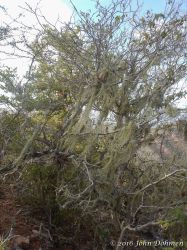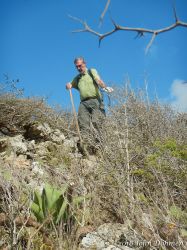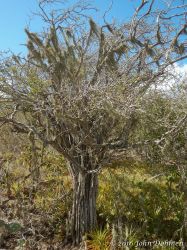 On February 18, 2016 we went back to the Christoffel park. This time an former archaeology sleuth joined us, Dirk, a long time member before he moved to The Netherlands. Being on vacation means that he can and will join us on our weekly hikes. Our target this time is the area were in the past manganese mining was done. There are known mines on the slope of the Seru Francisco Jobo but we wanted to check if there are unkown mining sites on the side of the Seru Bientu and the Seru Francisco Jobo.
On February 18, 2016 we went back to the Christoffel park. This time an former archaeology sleuth joined us, Dirk, a long time member before he moved to The Netherlands. Being on vacation means that he can and will join us on our weekly hikes. Our target this time is the area were in the past manganese mining was done. There are known mines on the slope of the Seru Francisco Jobo but we wanted to check if there are unkown mining sites on the side of the Seru Bientu and the Seru Francisco Jobo.
Today we started at the parking lot where the path to the Seru Bientu starts. But instead of following that path we went uphill to the South of the top. We went over the ridge to walk on the slope on the Western side of the ridge. We already checked part of this slope in the past.
It is not easy to walk on the steep slope because of a lot of loose rubble and not many sturdy plant to keep your balance. But we do like an adventurous hike. And we were rewarded with beautiful views over the surrounding area. To the West the ruins of Newtown and the village of Lagun, to the East the largest moutain peaks in the Christofflel park. In both directions an impressive view.
we checked a few suspicious looking rock formations but found no traces of mining. Same experience as last time.
We continued our hike towards the Seru Francisco Jobo. We didn't check our maps closely enough because we were all surprised to find a valley between the Seru Bientu and the Seru Francisco Jobo. From the side of the Seru Bientu we saw a suspicious looking cliff on the other mountain, so we went down into the valley. On our way down we discovered an almost intact case bottle, just when we were talking about the fact that there were no artifacts in this area. This is only the second time in all the years that we do these hikes that we find a complete case bottle. Normally we find only pieces.
At the lowest point we crossed an old road, visible on the Werbata map. We found, at the point were a dry-stone wall crosses that road, a bed of rocks. Strangely enough also a number of rounded rocks of a different constitution than the normal Knip Formation rocks. They looked like being from a vulcanic origin with a slighly different crust and an inside with very small crystals. We have no idea what the purpose was of this bed of rocks and how these variant rocks came here. Maybe it was an enforced piece of the road, but then only for a small part of the road.
We took our traditional apple break on this bed of rocks in the shade of some trees.
From there we went up in the direction of the strange-looking cliff. When we arrived there it appeared to be just a bare piece of the side of the mountain. No trace of mining here either.
Being relatively close to the top of this mountain we decided to go to the top before we returned. On the top we found the extension of the same dry-stone wall that we crossed earlier and that is running from the seru Bientu over the Seru Francisco Jobo. At the heighest point a Kadaster measuring point was placed on this dry-stone wall.
The way down in a straight line to the old dirt road was very difficult; it was even steeper than the slope of the Seru Bientu and there was the same kind of loose rubble here. And also numerous Bringamosa plants. I happened to touch one, very stingy. And at that time there is no Flaira in sight. So I rubbed my hand with leaves of the Welensali. Didn't help much, so I was happy to find a Flaira a bit further down. Crushing the leaves of this plant and rubbing my hand with it helped a lot to ease the pain.
When we finally arrived at the dirt road the two chauffeurs, Fred and Karel, offered to go the long way back (and uphill) via the dirt road to the cars while the others went downhill over that same dirt road to a crossing with the asphalt road where we were picked up by Fred and Karel.
We will come back next week to continue our search for mining activities other than the known mines on the side of the Seru Francisco Jobo.
 Our track projected on the Werbata map
Our track projected on the Werbata map An impressive Indju in the parking lot of Savonet
An impressive Indju in the parking lot of Savonet Look closely, there are cacti growing in the Indju
Look closely, there are cacti growing in the Indju We started our hike on the slope of the Seru Bientu
We started our hike on the slope of the Seru Bientu View from the ridge of the Seru Bientu in the direction of Lagun
View from the ridge of the Seru Bientu in the direction of Lagun Lots of hills in this area
Lots of hills in this area Wating till everyone is present
Wating till everyone is present in the foreground Newtown; to the right Lagun
in the foreground Newtown; to the right Lagun This tree is full with orchids, non-blooming
This tree is full with orchids, non-blooming This iguana is a bit sleepy
This iguana is a bit sleepy Doesn't look too good
Doesn't look too good Dry-stone wall
Dry-stone wall The trees in this area contain a lot of Usnea (kind of moss)
The trees in this area contain a lot of Usnea (kind of moss) The slope is steep and full of loose rocks
The slope is steep and full of loose rocks Nice example of Knip formation
Nice example of Knip formation A large Wayaca
A large Wayaca Colorful bark of the Wayaca
Colorful bark of the Wayaca Fungus on one of the branches of the Wayaca
Fungus on one of the branches of the Wayaca The termites make nice patterns in the dead wood
The termites make nice patterns in the dead wood This rock looks like a modern painting
This rock looks like a modern painting Another large Wayaca
Another large Wayaca
 Newtown
Newtown Brasia with an Agave
Brasia with an Agave The long stalk of the Agave bears young plants
The long stalk of the Agave bears young plants Lichen on a tree
Lichen on a tree Large Brasia with several Agave
Large Brasia with several Agave Sometimes it is easier to walk over a dry-stone wall
Sometimes it is easier to walk over a dry-stone wall Dirk is following
Dirk is following Nicely sculpted young Agave
Nicely sculpted young Agave Dry-stone wall
Dry-stone wall To our surprise an almost intact case bottle - a rare find
To our surprise an almost intact case bottle - a rare find Here was an old road - why this bed of rocks?
Here was an old road - why this bed of rocks? It is a good place to take our break
It is a good place to take our break Traces of the old road
Traces of the old road View towards the Seru Bientu from the side of the Seru Francisco Jobo
View towards the Seru Bientu from the side of the Seru Francisco Jobo Another nice Brasia
Another nice Brasia Kadaster measuring point on top of the Seru Francisco Jobo
Kadaster measuring point on top of the Seru Francisco Jobo Orchids growing in a cactus
Orchids growing in a cactus